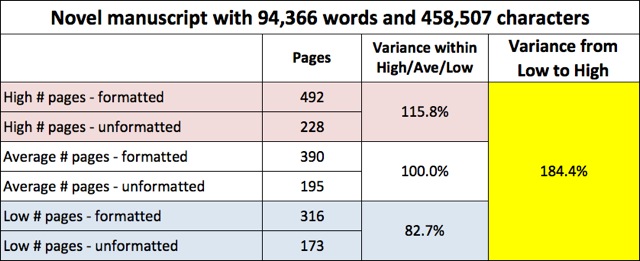Words Not Pages
I frequently hear from writers who are interested in a manuscript review or editing services, or who want to pitch an agent or publisher, and they tell me their book is 200 or 425 or howevermany pages long.
When I’m feeling indulgent and patient, I’ll spend some time explaining why I don’t care how many pages their manuscript is – and why they shouldn’t, either. What counts is the number of words in the manuscript, because that’s how “long” the work actually is.
Back in the day of Royals and Selectrics, “page” meant “page.” It meant, “About 250 words.”
Today, “page” means something so utterly removed from the typewriter days that it literally defies definition.
And if we’re talking about e-books, those things don’t even have pages.
As anyone who’s written (or graded) a high school or college term paper since the early 1990s can tell you, by tinkering with margins, fonts, line spacing — even leading, tracking, and kerning — an author can make a page whatever the author wants it to be.
That’s not necessarily what everyone in the publishing industry accepts “a page” to be.
To illustrate the difference between “how many pages” and “how long” a manuscript is, I altered several common formatting variables in a novel manuscript. You can see the details in the rest of this post, but the bottom line is this:
The difference between what two well-intentioned people mean when they talk about “number of pages” can vary as much as 185%.
Font
Typefaces are an embarrassment of riches that cause a lot of embarrassment. Different word processors default to different fonts. You can choose among hundreds of fonts. Fonts that are easy to read on a computer screen (sans serif fonts) are not as easy or comfortable to read on paper as serif fonts.
Without changing anything in “how long” the manuscript is (same number of words, same page breaks for chapters, same headers), I altered the font and font size of the manuscript to show the impact of several popular fonts and font sizes on “how many pages” there are in the manuscript.
The difference in number of pages based only on changing fonts and font sizes varied from 316 to 492 — a variance of 45% from the average number of pages in this spreadsheet.
As for the rule of thumb about 250 words per page, the average words/page in this spreadsheet is 246.4 (not shown). Different, and common, fonts and font sizes can vary the number of pages in your manuscript as much as 43% around that average.
Margins
Without changing anything in “how long” the manuscript is, I altered margins from manuscript format (1 inch) to the defaults of various word processors (1.25 or 1.5 inches) to measure margin’s impact on number of pages. I also considered a few popular fonts that produce about the same number of pages in the formatted manuscript.
The number of pages in the manuscript increases by an average of 11% if your word processor’s margins default to 1.25 inches, and by an average of 24% if your word processor’s margins default to 1.5 inches.
Formatting
Without changing anything in “how long” the manuscript is, I altered the formatting from traditional double-spaced lines and tabbed paragraphs to no formatting except paragraphs and tabs.
Within the unformatted manuscripts, the average number of words on a page varies from 414 to 545 — which is to say, a lot more than 250.
The number of pages varies between 173 and 228 — a 28% variance from the average number of pages — based only on font choice. These numbers are more dramatic, however, when compared to formatted manuscript:
Bottom line
The middle section of this spreadsheet — the white rows — is most compelling. If we look at the average number of pages in a formatted manuscript, considering various fonts and font sizes, and compare it to the average number of pages in an unformatted manuscript, considering various fonts (but not different font sizes), there is a 100% difference in the number of pages.
Two people talking about “how many pages” are in a manuscript may have a totally different interpretation of “how long” the manuscript really is.
Focus on the number of words in your work, not the number of pages.
The exception that proves this rule is that publishing pros — authors with multiple books and their agents, editors, and publishers — can shorthand “number of pages” because all of them operate on the industry-standard concept of a formatted manuscript.
You can learn more about proper manuscript formatting from plenty of books and web sites. A friend who teaches fiction writing at a university refers his students to the web site of author William Shunn, which you can reach by clicking here.







I’m glad I get FB feed to my inbox, or I would have missed this article. Very interesting information and stats (185?!). What fonts are the most accepted now, still Courier and Times New Roman? Thanks also for the link to William Shunn.
(see following comment for reply)
Agents and publishers will usually specify which font they want to see in their submission guidelines – that’s the most important answer.
Times and its variants are a very safe default. Courier and its variants are still expected for screenwriters, but IMHO it’s tougher to read over the long haul than Times, though I’m sure some in publishing prefer it because it’s what they’re accustomed to seeing. Cambria will become increasingly accepted because Microsoft defaults to that font.
Nicely done. I get manuscripts formatted many ways–one common one I didn’t see mentioned here is where there are 6 or 10 points of space added between each paragraph, which increases pages/length–and I wonder how agents/editors react to that kind of formatting.
Arrgghh! I get that all the time, too – and it’s particularly maddening in MS Word because you can’t ever find the hidden character that scres of the formatting when it accidentially gets copied or moved.
Good appendix from Ray Rhamey: Do not, under any circumstances, use the “points before/after” paragraph formatting tool. KISS: double-space between lines and call it good.
Fascinating comparison of fonts. Larry Brooks wrote not long ago that Courier is on the rise as a requested font (by agents as well as editors). What have you found?
I haven’t found anything consistent. Most writers never change the default setting on their word processor, so most manuscripts I see are in some variant of Times. People with a Hollywood orientation also tend to default towards Courier because it’s still the standard for screenplays.
If Larry mentioned that to me, I’d respond something like this:
I think most agents specify one or two unique particulars in their submission guidelines to see who’s paying attention. That makes it easier to weed out writers who aren’t, and if a typical agent is getting 700 or 800 submissions a week, weeding out becomes very important. Courier would be a great example of a weed-out specification because a reader can tell immediately if a document is in Courier; Times, Garamond, and Palatino are close enough that it’s hard to tell at first glance.